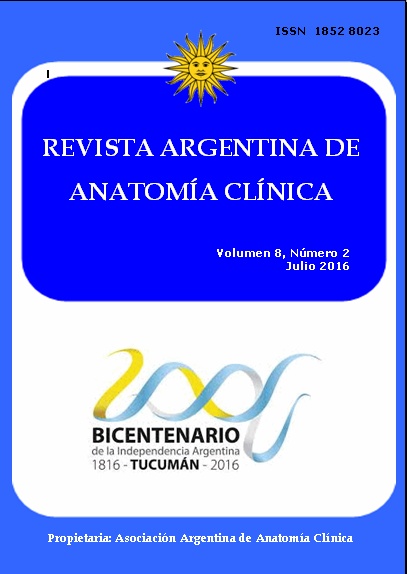TOPOGRAFÍA INTRANEURAL DE LA RAMA PROFUNDA DEL NERVIO ULNAR EN EL ANTEBRAZO DISTAL: ESTUDIO CADAVÉRICO. Intraneural topography of the deep branch of the ulnar nerve in the distal forearm: cadaveric study.
DOI:
https://doi.org/10.31051/1852.8023.v8.n2.14634Keywords:
transferencia nerviosa, interóseo anterior, ulnar, neurocirugía, rama profunda del nervio ulnar. nerve transfer, anterior interosseous nerve, neurosurgery, deep branch of the ulnar nerve.Abstract
Objetivo: estudiar la topografía intraneural de la rama profunda del nervio ulnar (RPNU) en el antebrazo distal en vistas a su identificación mediante disección intraneural mínima durante la transferencia del nervio del pronador cuadrado (NPC) a la RPNU. Materiales y métodos: En 15 antebrazos cadavéricos se fijó el paquete vasculonervioso ulnar a los planos musculares profundos cada un centímetro tomando como referencia el hueso pisiforme. Se disecó en sentido proximal la RPNU bajo microscopio quirúrgico (Olympus OME, 4-20x) y se registró su posición intraneural en base a una división en cuadrantes. Se midió la distancia desde el origen de la rama cutánea dorsal (RCD) del nervio ulnar al pisiforme y se registró su relación intraneural con la RPNU. Resultados: La RPNU se individualizó hasta 69mm (41-94) proximal al hueso pisiforme, ubicándose en el cuadrante posteromedial del nervio ulnar en el 78% (67-87), el 93% (92-93) y el 100% de los casos entre los 0-2, 3-6 y 7-9 centímetros, respectivamente. La distancia pisiforme-RCD fue de 63mm (52-83). En 11 miembros la disección de la RPNU se extendió proximalmente al origen de la RCD, ubicándose siempre entre esta última y la rama superficial del nervio ulnar. Conclusiones: La topografía intraneural de la RPNU en el sitio óptimo para su sección en vistas a su anastomosis con el NPC es predecible en la mayoría de los casos, lo que confirma la viabilidad de su identificación precisa mediante disección intraneural mínima.
Objective: to assess the intraneural anatomy of the deep branch of the ulnar nerve (DBUN) in the distal forearm in reference to its identification by means of minimal intraneural dissection during pronator quadratus nerve to DBUN transfers. Materials and methods: In 15 cadaveric forearms the ulnar neurovascular bundle was identified and attached to the subjacent muscles every one centimeter. Pisiform bone was used as reference. Intraneural proximal dissection of the deep branch of the ulnar nerve was performed under magnification (Olympus OME, 4-20x) and its intraneural position was registered using a quadrants scheme. Distance from pisiform to the origin of the dorsal cutaneous branch of the ulnar nerve (DCB) was measured and its intraneural position relative to DBUN was identified. Results: The DBUN could be identified up to 69mm (41-94) proximal to the pisiform and occupied the posteromedial quadrant of the ulnar nerve in 78% (67-87), 93% (92-93) and 100% of the cases in the 0-2, 3-6 and 7-9cm ranges, respectively. Distance from pisiform to the origin of the DCB was 63mm (52-83). The DBUN could be identified proximal to the origin of the DCB in 11 forearms, being located between the latter and the superficial branch of the ulnar nerve in all this cases. Conclusions: Intraneural topography of the DBUN in the most appropriate site for its identification during its anastomosis to the PQN is predictable in the majority of cases, which supports the viability of safe identification of the de DBUN by means of minimal intraneural dissection.
References
Barbour J, Yee A, Kahn LC, Mackinnon SE. 2012. Supercharged end-to-side anterior interosseous to ulnar motor nerve transfer for intrinsic musculature reinnervation. J Hand Surg Am 37:2150-9.
Battiston B, Lanzetta M. 1999. Reconstruction of high ulnar nerve lesions by distal double median to ulnar nerve transfer. J Hand Surg Am 24:1185-91.
Brown JM, Shah MN, Mackinnon SE. 2009. Distal nerve transfers: a biology-based rationale. Neurosurg focus 26:E12.
Brown JM, Yee A, Mackinnon SE. 2009. Distal median to ulnar nerve transfers to restore ulnar motor and sensory function within the hand: technical nuances. Neurosurgery 65:966-78.
Chow JA, Van Beek AL, Meyer DL, Johnson MC. 1985. Surgical significance of the motor fascicular group of the ulnar nerve in the forearm. J Hand Surg Am. 10:867-72.
Flores LP. 2011. Distal anterior interosseous nerve transfer to the deep ulnar nerve and end-to-side suture of the superficial ulnar nerve to the third common palmar digital nerve for treatment of high ulnar nerve injuries: experience in five cases. Arq Neuropsiquiatr 69:519-24.
Novak CB, Mackinnon SE. 2002. Distal anterior interosseous nerve transfer to the deep motor branch of the ulnar nerve for reconstruction of high ulnar nerve injuries. J Reconstr Microsurg 18:459-64.
Robert M, Blanc C, Gasnier P, Le Nen D, Hu W. 2011. Neurotisation de la branche profonde du nerf ulnaire par le nerf interosseux antérieur: étude anatomique. Chir Main 30:406-9.
Üstün ME, Ögün TC, Büyükmumcu M, Salbacak A. 2001. Selective restoration of motor function in the ulnar nerve by transfer of the anterior interosseous nerve. J Bone Joint Surg Am 83:549-52.
Wang Y, Zhu S. 1997. Transfer of a branch of the anterior interosseus nerve to the motor branch of the median nerve and ulnar nerve. Chin Med J (Engl) 110:216-9.
Downloads
Published
Issue
Section
License
Authors retain copyright and grant the journal right of first publication with the work simultaneously licensed under a Creative Commons Attribution License that allows others to share the work with an acknowledgement of the work's authorship and initial publication in this journal. Use restricted to non commercial purposes.
Once the manuscript has been accepted for publications, authors will sign a Copyright Transfer Agreement to let the “Asociación Argentina de Anatomía Clínica” (Argentine Association of Clinical Anatomy) to edit, publish and disseminate the contribution.



